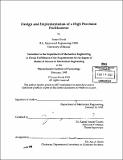Design and implementation of a high precision profilometer
Author(s)
Kwok, Tarzen
DownloadFull printable version (6.310Mb)
Other Contributors
Massachusetts Institute of Technology. Dept. of Mechanical Engineering.
Advisor
Kamal Youcef-Toumi.
Terms of use
Metadata
Show full item recordAbstract
A high precision profilometry system was developed primarily for the inspection of two-sided sample specimens. Based upon system specifications and requirements, it was found that the most suitable profilometry technique was atomic force microscopy (AFM). The major components of the profilometer were: 1) a commercial atomic force microscope, 2) customized sample positioning hardware, 3) image processing and control software, and 4) system calibration procedures. The primary focus of this thesis is on the design and implementation of the customized blade positioning hardware, consisting of two linear stages stacked to form an X-Y table and a novel 'flip' stage which allows both sides of the sample to be measured by the AFM. The flip stage uses a kinematic coupling design to achieve the necessary positioning precision and stability. A homogeneous transformation matrix (HTM) method was developed for calculating the profiling errors due to stage positioning errors. The actual performance and calibration of the profilometer system was investigated through various tests, including: 1) measurement / positioning repeatibility tests of individual components, 2) measurement accuracy tests (documented in a separate report), and 3) other tests, such as determination of measurement sensitivity, drift rates, and system natural frequency.
Description
Thesis (S.M.)--Massachusetts Institute of Technology, Dept. of Mechanical Engineering, 1995. Includes bibliographical references (p. 113-117 [i.e. p. [86]-[88]).
Date issued
1995Department
Massachusetts Institute of Technology. Department of Mechanical EngineeringPublisher
Massachusetts Institute of Technology
Keywords
Mechanical Engineering.